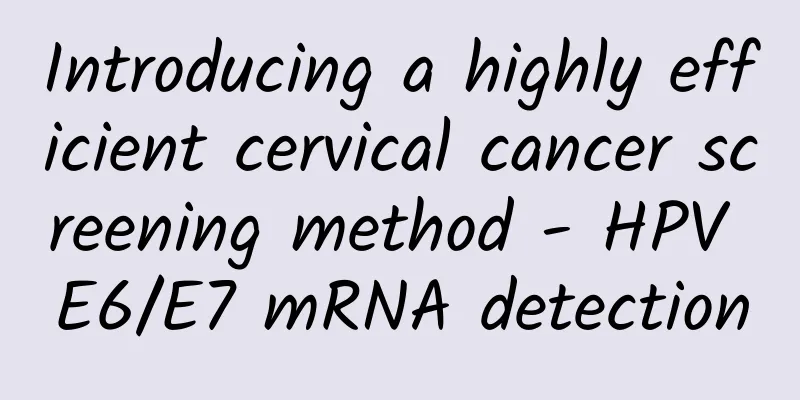Introducing a highly efficient cervical cancer screening method - HPV E6/E7 mRNA detection

|
Author: Guo Shanlan, deputy chief physician of Ziyang Hospital, West China Hospital, Sichuan University Reviewer: Tao Shibing, Chief Physician, Ziyang Hospital, West China Hospital, Sichuan University The term "cervical cancer" is probably familiar to female friends. They will panic when they hear it. After all, cervical cancer is the fourth most common malignant tumor in women worldwide. Among the pathogenic factors of cervical cancer, human papillomavirus (HPV) infection is a very important cause. Figure 1 Copyright image, no permission to reprint There are more than 200 types of HPV that have been discovered so far, and they are divided into high-risk and low-risk types according to their carcinogenicity. In the occurrence and development of cervical cancer, a key substance is indispensable - HPV E6/E7 mRNA (messenger RNA encoded by the E6 and E7 genes in human papillomavirus). The HPV genome is a double-stranded circular DNA (deoxyribonucleic acid), which can be understood as a ring formed by two parallel and interconnected ropes. This ring is not completely closed, but is composed of multiple small fragments of varying lengths. Among the many small fragments, the two most "dangerous" genes are the E6 and E7 fragments. The messenger RNA produced by the transcription of the E6 and E7 genes, namely HPV E6/E7 mRNA, is an intermediate product of viral gene expression, which can destroy the regulatory mechanism in the cell, causing uncontrolled cell proliferation, thereby promoting the occurrence of tumors. In other words, those HPV viruses that can stably and continuously produce E6/E7 mRNA are the most carcinogenic. Figure 2 Copyright image, no permission to reprint 60% to 80% of women have been infected with HPV in their lifetime, but most HPV viruses will be cleared by their own immune system. Women only experience transient infections and will not develop cervical cancer. Figure 3 Copyright image, no permission to reprint But sometimes, HPV viruses will continue to exist in the human body. Some of them are very good at disguising themselves, turning themselves into linear structures, sneaking into and integrating into the human genome, and then producing a large number of "combat messengers" (E6/E7 mRNA). These messengers will disrupt the instructions given by the human body, so the virus begins to "attack the city" and "burn, kill and rob" in the cervix. Cervical cells gradually become diseased in the destruction, slowly developing from low-grade lesions to high-grade lesions, and eventually leading to cervical cancer. Therefore, the excessive production of E6/E7 mRNA is a molecular signal for the virus to begin to cause disease. Figure 4 Copyright image, no permission to reprint When women have cervical precancerous lesions, they usually have no obvious symptoms and signs. It is impossible to diagnose by naked eye observation alone and requires professional screening technology. Since infection with high-risk HPV does not necessarily develop into cervical cancer, it is far from enough to simply detect whether a woman is infected with high-risk HPV. It is also necessary to accurately identify those who will develop cancer and provide more accurate disease management for them. Now, the latest HPV E6/E7 mRNA detection method can greatly improve the screening efficiency, detect whether there are "combat messengers" (HPV E6/E7 mRNA) in women's cervical cells, and further understand the status of HPV infection, and determine whether the HPV virus in the body is "passing by" or intends to "set up camp." Figure 5 Copyright image, no permission to reprint In fact, only a small number of people with persistent infection may develop cervical cancer, and this process generally takes 5 to 12 years, so there is enough time to detect and block the occurrence and development of cervical cancer. Early detection of cervical lesions is very important. The 5-year survival rate after early cervical cancer treatment can reach 90%. Therefore, the earlier HPV E6/E7 mRNA is found in the cervix, the earlier the risk of cancer can be identified, and early detection, early diagnosis, and early treatment can be achieved. HPV E6/E7 mRNA detection technology can detect whether E6 and E7 are overexpressed in the pathogenic genes of 14 high-risk HPV viruses. It can not only evaluate the risk of occurrence and progression of cervical lesions, but also evaluate the prognosis of cervical cancer patients. Of course, during the development of cervical lesions, there will be changes in the morphology of cervical cells. Therefore, liquid-based cytology is also used in clinical practice to observe the morphological characteristics of cervical cells to determine the extent of cervical lesions. Liquid-based cytology is a pathological detection technology that collects cervical epithelial cell samples, makes them into cell smears, and observes the cell morphology under a microscope. It can detect early cervical precancerous lesions and is also a cervical cytology detection technology currently widely used in clinical practice. HPV E6/E7 mRNA testing combined with liquid-based cytology is the golden combination for HPV screening. Two tests can be performed simultaneously with one sample. It can not only evaluate whether there are current lesions in cervical cells and the extent of the current lesions, but also predict the future development trend of the lesions through the synthesis of carcinogenic proteins. It is an economical and affordable testing combination. Figure 6 Copyrighted images are not authorized for reproduction In fact, cervical cancer is relatively not that scary. It is a cancer with a very clear cause and can be prevented and detected early. Some people may also have a prognosis in the precancerous stage. Only by identifying the risk in time can we respond in time. It is recommended that women aged 9 to 45 years old be vaccinated with HPV vaccine, and women over 25 years old should undergo cervical cancer screening every 3 to 5 years to stay away from cervical cancer as much as possible! |
<<: Let's learn about familial Mediterranean fever
Recommend
How many days after medical abortion?
After medical abortion, the tissues and fluids of...
What to do if your vulva is dry
In daily life, many women find that they have the...
What are the early signs of pregnancy
What are the symptoms of early pregnancy? Women a...
Health Tips | Is a cold most contagious when you are almost recovering?
A cold usually refers to a disease caused by path...
Getting hungry quickly during early pregnancy is a good thing
About a month after a woman successfully gives bi...
Bacterial vaginitis
The disease of bacterial vaginitis is mainly caus...
What to do if you have menstrual depression
During women's menstrual period, many women e...
How are the Great Lord realms divided? What is Mu Chen's final realm?
The Great Lord, starring Wang Yuan and Ouyang Nan...
Pregnancy and baby development process pictures
After a woman becomes pregnant, the baby will con...
What should I do if my vagina becomes loose after giving birth?
It takes a lot of effort for every woman to have ...
What is the correct way to massage your breasts?
Every woman wants to have an impressive bust, bec...
Can I take ibuprofen while trying to conceive?
From the beginning of pregnancy, couples need to ...
What should I do if my ovaries don't ovulate?
If the ovaries do not ovulate, the first thing th...
Anal pain in late pregnancy
Once a woman enters the late stage of pregnancy, ...









